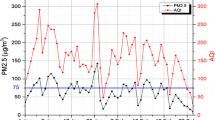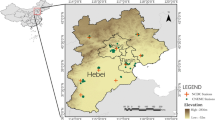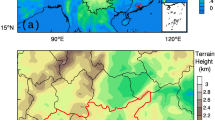Abstract
This study used daily air pollution data (PM2.5, PM10, SO2, NO2, CO, and O3) from nine monitoring stations in Wuhan city to calculate the air quality index (AQI) from 2013 to 2017. Together with this data, L-band sounding data, ground meteorological data, and air mass back trajectories were also used to describe the dynamics of atmospheric boundary layer (ABL) during pollution process. Analysis of the results shows that, even though the city is still polluted, the number of polluted days was decreasing. Ranking the years in terms of pollution status shows that the year 2013 was the most polluted year while the year 2017 was the cleanest year. Average annual limit of PM10, PM2.5, and NO2 during these 5 years were 1.3~1.8, 1.5~2.7, and 1.2~1.5 times higher than the annual average acceptable limit, respectively. The average ratio of PM2.5/PM10 for 5 years was 0.67 which signifies that a significant portion of PM2.5 accounted for the total mass of PM10. Moreover, the condition of ABL during the pollution process shows the dominance of strong ground inversion and weak to calm winds. These conditions are not favorable for horizontal and vertical mixing of air pollutants and prevent dilution of pollutants with clean air. Mean cluster analysis of air mass back trajectory shows that pollutants of local origin were more important than the trans-boundary movement of air pollutants. This indicates that the observed pollution in Wuhan was more of local origin.




Similar content being viewed by others
Change history
20 February 2019
The original version of this article unfortunately contained an error in the Figure 2 caption.
References
Acciai, C., Zhang, Z., Wang, F., Zhong, Z., & Lonati, G. (2017). Characteristics and source analysis of trace elements in PM2.5 in the urban atmosphere of Wuhan in spring. Aerosol and Air Quality Research, 17, 2224–2234. https://doi.org/10.4209/aaqr.2017.06.0207.
Chen, Y., Jin, G. Z., Kumar, N., & Shi, G. (2012). Gaming in air pollution data? Lessons from China. Journal of Economic Analysis & Policy, Advances, 13(3), 1–42. https://doi.org/10.3386/w18729.
Dimitriou, K. (2015). The dependence of PM size distribution from meteorology and local-regional contributions, in Valencia (Spain) – a CWT model approach. Aerosol and Air Quality Research, 15, 1979–1989. https://doi.org/10.4209/aaqr.2015.03.0162.
Dimitriou, K., & Kassomenos, P. (2014). Indicators reflecting local and transboundary sources of PM2.5and PMCOARSEin Rome - impacts in air quality. Atmospheric Environment, 96, 154–162. https://doi.org/10.1016/j.atmosenv.2014.07.029.
Feng, Z., Hu, E., Wang, X., Jiang, L., & Liu, X. (2015). Ground-level O3 pollution and its impacts on food crops in China: a review. Environmental Pollution, 199, 42–48. https://doi.org/10.1016/j.envpol.2015.01.016.
GB3095 (2012). People’s Republic of China National Ambient Air Quality Standard. China. Available online: http://210.72.1.216:8080/gzaqi/Document/gjzlbz.pdf. Accessed 07 Dec 2017.
HJ633 (2012). Technical requirements for ambient air quality index (AQI) (Trial Implementation), People’s Republic of China, National Environmental Protection Standard. China. Available online: http://210.72.1.216:8080/gzaqi/Document/aqijsgd.pdf Accessed 07 Dec 2017.
Hu, X. M., Ma, Z., Lin, W., Zhang, H., Hu, J., Wang, Y., Xu, X., Fuentes, J. D., & Xue, M. (2014). Impact of the Loess Plateau on the atmospheric boundary layer structure and air quality in the North China Plain: a case study. Science of the Total Environment, 499, 228–237. https://doi.org/10.1016/j.scitotenv.2014.08.053.
Inomata, Y., Igarashi, Y., Chiba, M., Shinoda, Y., & Takahashi, H. (2009). Dry and wet deposition of water-insoluble dust and water-soluble chemical species during spring 2007 in Tsukuba, Japan. Atmospheric Environment, 43(29), 4503–4512. https://doi.org/10.1016/j.atmosenv.2009.06.048.
Jeong, U., Kim, J., Lee, H., Jung, J., Kim, Y. J., Song, C. H., & Koo, J. H. (2011). Estimation of the contributions of long range transported aerosol in East Asia to carbonaceous aerosol and PM concentrations in Seoul, Korea using highly time resolved measurements: a PSCF model approach. Journal of Environmental Monitoring, 13(7), 1905–1918. https://doi.org/10.1039/c0em00659a.
Lee, S., Ho, C. H., Lee, Y. G., Choi, H. J., & Song, C. K. (2013). Influence of transboundary air pollutants from China on the high-PM10 episode in Seoul, Korea for the period October 16–20, 2008. Atmospheric Environment, 77, 430–439. https://doi.org/10.1016/j.atmosenv.2013.05.006.
Li, G., Bei, N., Cao, J., Wu, J., Long, X., Feng, T., et al. (2017). Widespread and persistent ozone pollution in eastern China during the non-winter season of 2015: observations and source attributions. Atmospheric Chemistry and Physics, 17, 2759–2774. https://doi.org/10.5194/acp-17-2759-2017.
Li, X., Wang, Y., Zhao, H., Hong, Y., Liu, N., & Ma, Y. (2018). Characteristics of pollutants and boundary layer structure during two haze events in summer and autumn 2014 in Shenyang, Northeast China. Aerosol and Air Quality Research, 18, 386–396. https://doi.org/10.4209/aaqr.2017.03.0100.
Liu, T., Tian, T., Hui, Y., Jun, Y., Qian, X., Yan, H., et al. (2013). The short-term effect of ambient ozone on mortality is modified by temperature in Guangzhou, China. Atmospheric Environment, 76, 59–67. https://doi.org/10.1016/j.atmosenv.2012.07.011.
Lu, H.-Y., Mwangi, J. K., Wang, L.-C., Wu, Y.-L., Tseng, C.-Y., & Chang, K.-H. (2016). Atmospheric PM2.5 characteristics and long-term trends in Tainan city, Southern Taiwan. Aerosol and Air Quality Research, 16(10), 2488–2511. https://doi.org/10.4209/aaqr.2016.07.0332.
Lyu, X. P., Chen, N., Guo, H., Zeng, L., Zhang, W., Shen, F., et al. (2016). Chemical characteristics and causes of airborne particulate pollution in warm seasons in Wuhan, central China. Atmospheric Chemistry and Physics, 16(16), 10671–10687. https://doi.org/10.5194/acp-16-10671-2016.
Mbululo, Y., Qin, J., & Yuan, Z. (2017). Evolution of atmospheric boundary layer structure and its relationship with air quality in Wuhan, China. Arabian Journal of Geosciences, 10(22), 1–12. https://doi.org/10.1007/s12517-017-3257-9.
Polissar, A. V., Hopke, P. K., Paatero, P., Kaufmann, Y. J., Hall, D. K., Bodhaine, B. A., et al. (1999). The aerosol at Barrow, Alaska: long-term trends and source locations. Atmospheric Environment, 33, 2441–2458.
Quan, J., Gao, Y., Zhang, Q., Tie, X., Cao, J., Han, S., Meng, J., Chen, P., & Zhao, D. (2013). Evolution of planetary boundary layer under different weather conditions, and its impact on aerosol concentrations. Particuology, 11(1), 34–40. https://doi.org/10.1016/j.partic.2012.04.005.
Ran, L., Zhao, C., Geng, F., Tie, X., Tang, X., Peng, L., Zhou, G., Yu, Q., Xu, J., & Guenther, A. (2009). Ozone photochemical production in urban Shanghai, China: analysis based on ground level observations. Journal of Geophysical Research, 114, 1–14. https://doi.org/10.1029/2008JD010752.
Rolph, G., Stein, A., & Stunder, B. (2017). Real-time environmental applications and display system: READY. Environmental Modelling and Software, 95, 210–228. https://doi.org/10.1016/j.envsoft.2017.06.025.
Stein, A. F., Draxler, R. R., Rolph, G. D., Stunder, B. J. B., Cohen, M. D., & Ngan, F. (2015). NOAA’s HYSPLIT atmospheric transport and dispersion modeling system. Bulletin of the American Meteorological Society, 96(12), 2059–2077. https://doi.org/10.1175/BAMS-D-14-00110.1.
Tang, G., Zhu, X., Xin, J., Hu, B., Song, T., Sun, Y., Zhang, J., Wang, L., Cheng, M., Chao, N., Kong, L., Li, X., & Wang, Y. (2017). Modelling study of boundary-layer ozone over northern China—part I: ozone budget in summer. Atmospheric Research, 187, 128–137. https://doi.org/10.1016/j.atmosres.2016.10.017.
Tao, Y., Huang, W., Huang, X., Zhong, L., Lu, S., Li, Y., et al. (2012). Estimated acute effects of ambient ozone and nitrogen dioxide on mortality in the Pearl River Delta of Southern China. Environmental Health Perspectives, 120(3), 393–398.
Wan, W., Xie, X., & Zhang, S. (2012). Health effect valuation of ground-level ozone control in Beijing and its surrounding areas, China. Advanced Materials Research, 360, 585–589. https://doi.org/10.4028/www.scientific.net/AMR.356-360.585.
Wang, Y. Q., Zhang, X. Y., & Draxler, R. R. (2009). TrajStat: GIS-based software that uses various trajectory statistical analysis methods to identify potential sources from long-term air pollution measurement data. Environmental Modelling and Software, 24(8), 938–939. https://doi.org/10.1016/j.envsoft.2009.01.004.
Wang, S., Yu, S., Yan, R., Zhang, Q., Li, P., Wang, L., Liu, W., & Zheng, X. (2016). Characteristics and origins of air pollutants in Wuhan, China, based on observations and hybrid receptor models. Journal of the Air & Waste Management Association, 2247, 10962247.2016.1240724–10962247.2016.1240753. https://doi.org/10.1080/10962247.2016.1240724.
Wang, T., Xue, L., Brimblecombe, P., Fat, Y., Li, L., & Zhang, L. (2017). Ozone pollution in China: a review of concentrations, meteorological influences, chemical precursors, and effects. Science of the Total Environment, 575, 1582–1596. https://doi.org/10.1016/j.scitotenv.2016.10.081.
WHO. (2016). Ambient air pollution: a global assessment of exposure and burden of diseases. Geneva, Switzerland. http://apps.who.int/iris/bitstream/10665/250141/1/9789241511353-eng.pdf?ua=1. Accessed 06 Nov 2017.
Wu, M., Wu, D., Fan, Q., Wang, B. M., Li, H. W., & Fan, S. J. (2013). Observational studies of the meteorological characteristics associated with poor air quality over the Pearl River Delta in China. Atmospheric Chemistry and Physics, 13, 10755–10766. https://doi.org/10.5194/acp-13-10755-2013.
Xin, Y., Wang, G., & Chen, L. (2016). Identification of long-range transport pathways and potential sources of PM10 in Tibetan Plateau uplift area: case study of Xining, China in 2014. Aerosol and Air Quality Research, 16, 1044–1054. https://doi.org/10.4209/aaqr.2015.05.0296.
Xu, G., Jiao, L., Zhang, B., Zhao, S., Yuan, M., Gu, Y., & Liu, J. (2017). Spatial and temporal variability of the PM2.5/PM10 ratio in Wuhan, Central China. Aerosol and Air Quality Research, 17(2016), 741–751. https://doi.org/10.4209/aaqr.2016.09.0406.
Yassin, M. F., Al-Shatti, L. A., & Al Rashidi, M. S. (2018). Assessment of the atmospheric mixing layer height and its effects on pollutant dispersion. Environmental Monitoring and Assessment, 190(7). https://doi.org/10.1007/s10661-018-6737-9.
Zeng, Y., & Hopke, P. K. (1989). A study of the sources and acid precipitation in Ontario, Canada. Atmospheric Environment, 23(7), 1499–1509.
Zhang, X. X., Sharratt, B., Liu, L. Y., Wang, Z. F., Pan, X., Le, Lei., et al. (2018). East Asian dust storm in May 2017: Observations, modelling, and its influence on the Asia-Pacific region. Atmospheric Chemistry and Physics, 18(11), 8353–8371. https://doi.org/10.5194/acp-18-8353-2018.
Acknowledgements
The authors gratefully acknowledge the support of this research by the National Key Research and Development Program of China (2016YFA0602002 and 2017YFC0212603). Thanks to NOAA Air Resources Laboratory (ARL) for the provision of the HYSPLIT transport and dispersion model and/or READY website (http://www.ready.noaa.gov) used in this study. Last but not least, we would like to express our sincere appreciation to the editorial board and two anonymous reviewers for their constructive comments, corrections and suggetions.
Author information
Authors and Affiliations
Corresponding author
Additional information
Publisher’s Note
Springer Nature remains neutral with regard to jurisdictional claims in published maps and institutional affiliations.
Electronic supplementary material
ESM 1
(DOCX 16 kb)
Rights and permissions
About this article
Cite this article
Mbululo, Y., Qin, J., Yuan, Z. et al. Boundary layer perspective assessment of air pollution status in Wuhan city from 2013 to 2017. Environ Monit Assess 191, 69 (2019). https://doi.org/10.1007/s10661-019-7206-9
Received:
Accepted:
Published:
DOI: https://doi.org/10.1007/s10661-019-7206-9




